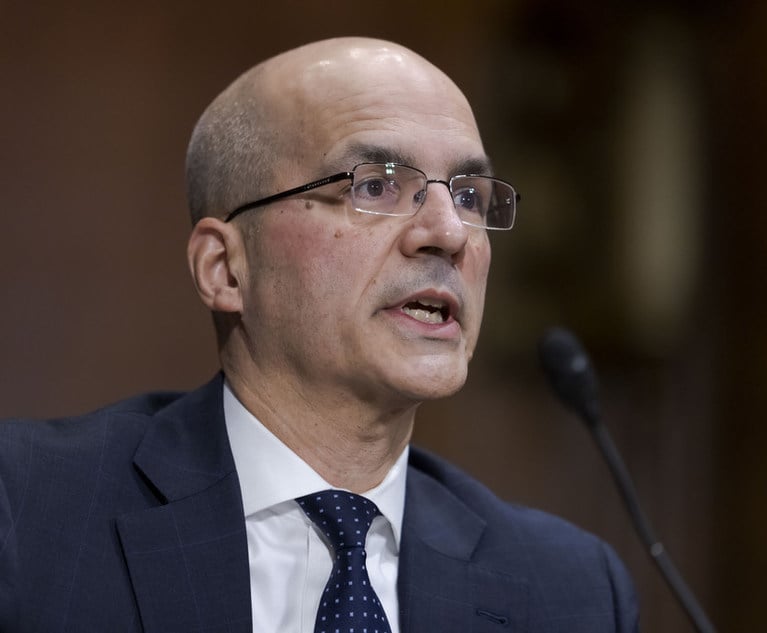Trademarks and 'Immoral or Scandalous Marks' From a Business, Legal and Marketing Perspective
When faced with a client company using a scandalous name, attorneys should discuss with the client both the possibility of the name attracting customers with the target persona, as well as the potential to turn off potential customers in the secondary group.
March 19, 2020 at 11:30 AM
7 minute read
 Every brand wants to be memorable to the consumer, particularly consumers in the target market where a brand feels there is great potential. It's not enough to be memorable, but also a brand first needs to capture the consumer's attention in what is now a very crowded, competitive space. One way for a brand to capture attention may be a clever, risqué, vulgar or even obscene name that attracts attention. Memorable to some may also be off-putting to others.
Every brand wants to be memorable to the consumer, particularly consumers in the target market where a brand feels there is great potential. It's not enough to be memorable, but also a brand first needs to capture the consumer's attention in what is now a very crowded, competitive space. One way for a brand to capture attention may be a clever, risqué, vulgar or even obscene name that attracts attention. Memorable to some may also be off-putting to others.
In the past, companies that chose the risqué, vulgar or obscene route found that the U.S. Patent and Trademark Office (USPTO) placed an obstacle to registering these types of trademarks and logos under the Lanham Act. The Lanham Act (also known as the Trademark Act of 1946) is the federal statute that governs trademarks, service marks, and unfair competition. Section 1052(a) of the Lanham Act states that the registration of a trademark shall be refused if it consists of "immoral, deceptive, or scandalous" matter.
Federal registration of trademarks is not a requirement to enter into interstate commerce. Products and services acquire rights under the common law with use in commerce within a territory. Those rights extend through the territory where the product is sold or the service is provided, plus a reasonable expansion around the territory. Most states also have trademark registries for products and services that are exchanged in intrastate commerce. Products and services that are protected under the common law or state registry display the TM symbol.
So, if federal registration is not required, why do so many brands seek it? Moreover, what does it mean if your application is refused because it is deemed immoral, deceptive or scandalous, as prohibited under the Lanham Act?
Erik Brunetti co-founded a line of clothing and accessories targeting skateboarders and started selling goods in 1991. The clothing designs had an edgy vibe. The line was branded F.U.C.T. for Friends U (You) Can Trust. It was no accident that the name also was a homophone of a curse word often seen in graffiti. The brand appealed to skateboarders and their followers, while putting-off other people with a more conventional attitude towards what is an appropriate name and trademark. Regardless, the company was very successful and the brand did well without federal registration.
What prompted Brunetti to apply to the USPTO in 2011?
The simple answer is that in the ensuing 20 years, commerce changed. The knockoffs and counterfeits of traditional retail infiltrated Internet commerce, plus other challenges arose. Having federal registration of the brand name would give Brunetti new tools to stop any imported counterfeits and imitators at the borders through enforcement of the trademark laws by Customs. Securing registration would also make infringement a federal matter, giving Brunetti access to Federal courts in all 50 states, as well as to the International Trade Commission, to sue such alleged infringers. Competition made registering the name essential for the viability of the business.
Brunetti's registration was initially refused by the USPTO. He appealed to the Trademark Trial and Appeal Board, an administrative court within the USPTO and lost there, too. He took his appeal to the Federal Circuit and finally won.
Around the same time, the Supreme Court heard the case Matal v. Tam, a Lanham Act challenge on whether trademarks that were considered disparaging could be refused registration by the USPTO. In that case, the court ruled that the disparaging part of 15 U.S.C. §1052(a) violated the First Amendment. Having lost at the Federal Circuit, the USPTO decided to appeal to the Supreme Court to determine a bright line concerning whether the remaining terms immoral or scandalous in that section should be struck down as unconstitutional. At the end of the 2019 term, in Iancu v. Brunetti, the Supreme Court held that the prohibition against immoral or scandalous marks infringes upon the First Amendment. (Deceptive marks are still prohibited.)
As an attorney, how do you advise a client now that restrictions such as immoral, scandalous or disparaging are no longer a barrier to registration? Marketers suggest trademarking a new brand immediately to avoid any issues with similar names, counterfeits and knockoffs down the road. (It is much more expensive to rebrand an existing company or product than to have it protected by trademark.)
What do you counsel if the client's choice of name for registration is personally repugnant? As attorneys, we may not have a strong background in branding and marketing, so how do we advise our clients in choosing a brand name with issues that may lie outside whether it is legal to use a trademark. What advice should we give? In this situation, attorneys should counsel the client to conduct thorough market research into the product category, name, customer base (or segment), etc., prior to choosing a brand name, so that the client understands the advantages and disadvantages of their name choice.
Does the use of an immoral or scandalous mark contribute to the success of the brand or does it limit its appeal? Companies should carefully research their target customer markets to make sure their market is amenable to positively responding to a scandalous name of a company, product or service.
Companies should create a customer persona or avatar, defined as a fictionalized person representing the majority of customers to whom the product or service will appeal. The customer persona is a composite of both demographics (such as the product or services buyer's age, gender, income level, educational level, marital status, where they live, etc.) and psychographics (such as the product or services buyer's habits, hobbies, values, their political party, which causes they support, etc.) to make sure their customers will respond positively to the name.
Businesses should also conduct forecasting (predicting future trends in the market and how they will affect sales, expenditures and profits) to project market niches for growth—different customer groups, different product uses, etc.—so that the scandalous name isn't a turn off that impedes bringing in new customers. In some cases, it may be appropriate to rename the product for the secondary customer personas. If the product is sufficiently different in nature and appeals to a different market segment, then the company should consider using a different name altogether that separates it from the company with the scandalous name. For instance, the business may incorporate the new company as a separate entity to avoid confusion and customer bias.
In sum, when faced with a client company using a scandalous name, attorneys should discuss with the client both the possibility of the name attracting customers with the target persona, as well as the potential to turn off potential customers in the secondary group. In addition, applying for the trademark name at an early date will likely stave off would-be competitors in the future. If the client fails to anticipate these circumstances, the business may suffer the homonymic fate of Brunetti's company.
Patricia Werschulz is an intellectual property lawyer and a registered patent attorney at Werschulz Patent Law. Sandra Holtzman is chief marketing strategist at Marketing Cures, a marketing, communications, public relations, digital and market research company.
This content has been archived. It is available through our partners, LexisNexis® and Bloomberg Law.
To view this content, please continue to their sites.
Not a Lexis Subscriber?
Subscribe Now
Not a Bloomberg Law Subscriber?
Subscribe Now
NOT FOR REPRINT
© 2025 ALM Global, LLC, All Rights Reserved. Request academic re-use from www.copyright.com. All other uses, submit a request to [email protected]. For more information visit Asset & Logo Licensing.
You Might Like
View All
'Serious Legal Errors'?: Rival League May Appeal Following Dismissal of Soccer Antitrust Case
6 minute read
How Some Elite Law Firms Are Growing Equity Partner Ranks Faster Than Others
4 minute read
Law Firms Mentioned
Trending Stories
- 1Haynes and Boone Expands in New York With 7-Lawyer Seward & Kissel Fund Finance, Securitization Team
- 2Upstart Insurer That's Wowing Industry Hires AIG Legal Exec to Help Guide Global Expansion
- 3Connecticut Lawyers in Spotlight for Repping FBI Agents
- 4SEC Sued for Failing to Reveal Records Involving Simpson Thacher Attorney
- 5Lawsuit Accuses University of California of Racial Discrimination in Admissions
Who Got The Work
J. Brugh Lower of Gibbons has entered an appearance for industrial equipment supplier Devco Corporation in a pending trademark infringement lawsuit. The suit, accusing the defendant of selling knock-off Graco products, was filed Dec. 18 in New Jersey District Court by Rivkin Radler on behalf of Graco Inc. and Graco Minnesota. The case, assigned to U.S. District Judge Zahid N. Quraishi, is 3:24-cv-11294, Graco Inc. et al v. Devco Corporation.
Who Got The Work
Rebecca Maller-Stein and Kent A. Yalowitz of Arnold & Porter Kaye Scholer have entered their appearances for Hanaco Venture Capital and its executives, Lior Prosor and David Frankel, in a pending securities lawsuit. The action, filed on Dec. 24 in New York Southern District Court by Zell, Aron & Co. on behalf of Goldeneye Advisors, accuses the defendants of negligently and fraudulently managing the plaintiff's $1 million investment. The case, assigned to U.S. District Judge Vernon S. Broderick, is 1:24-cv-09918, Goldeneye Advisors, LLC v. Hanaco Venture Capital, Ltd. et al.
Who Got The Work
Attorneys from A&O Shearman has stepped in as defense counsel for Toronto-Dominion Bank and other defendants in a pending securities class action. The suit, filed Dec. 11 in New York Southern District Court by Bleichmar Fonti & Auld, accuses the defendants of concealing the bank's 'pervasive' deficiencies in regards to its compliance with the Bank Secrecy Act and the quality of its anti-money laundering controls. The case, assigned to U.S. District Judge Arun Subramanian, is 1:24-cv-09445, Gonzalez v. The Toronto-Dominion Bank et al.
Who Got The Work
Crown Castle International, a Pennsylvania company providing shared communications infrastructure, has turned to Luke D. Wolf of Gordon Rees Scully Mansukhani to fend off a pending breach-of-contract lawsuit. The court action, filed Nov. 25 in Michigan Eastern District Court by Hooper Hathaway PC on behalf of The Town Residences LLC, accuses Crown Castle of failing to transfer approximately $30,000 in utility payments from T-Mobile in breach of a roof-top lease and assignment agreement. The case, assigned to U.S. District Judge Susan K. Declercq, is 2:24-cv-13131, The Town Residences LLC v. T-Mobile US, Inc. et al.
Who Got The Work
Wilfred P. Coronato and Daniel M. Schwartz of McCarter & English have stepped in as defense counsel to Electrolux Home Products Inc. in a pending product liability lawsuit. The court action, filed Nov. 26 in New York Eastern District Court by Poulos Lopiccolo PC and Nagel Rice LLP on behalf of David Stern, alleges that the defendant's refrigerators’ drawers and shelving repeatedly break and fall apart within months after purchase. The case, assigned to U.S. District Judge Joan M. Azrack, is 2:24-cv-08204, Stern v. Electrolux Home Products, Inc.
Featured Firms
Law Offices of Gary Martin Hays & Associates, P.C.
(470) 294-1674
Law Offices of Mark E. Salomone
(857) 444-6468
Smith & Hassler
(713) 739-1250







